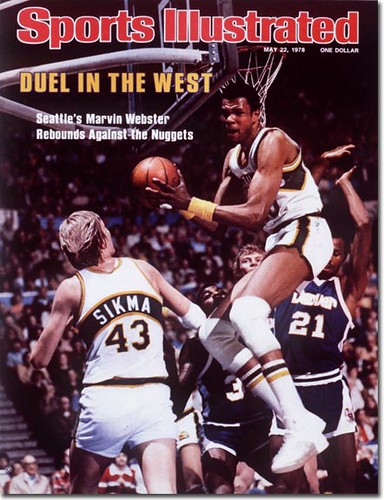Wouldn’t you like to be called The Human Eraser? That’s the kind of nickname you can really only get in a couple of places: comic books – could be a bad guy or a good guy, really – or in professional sports.
Marvin Webster was found dead in his hotel room in Tulsa, Oklahoma last Friday. He was 56. And throughout his career as a professional basketball player, he was known as The Human Eraser. Webster was seven foot one and while he could shoot the ball okay, he made his reputation and his nickname for the highly specialized art of blocking shots. Knowing where the ball was, knowing how the opponent was going to shoot it, and knowing where to be to whack it away. Whack. Erased. In basketball, players who can do everything well have a clear shot at success. If you can score, pass, defend, if you can be Michael Jordan or LeBron James, your path is clear and you might be a household name. But there’s another whole class of player, guys like Marvin Webster, who do well for themselves by honing one skill until they’re at an elite level doing it.
Webster was a star college player at Morgan State University in his hometown of Baltimore. He averaged 21 points a game, 22 rebounds a game but what really raised eyebrows was his average of 8 blocked shots per contest. It was his ticket to the big leagues. He played two seasons with the Denver Nuggets before being traded to the Seattle SuperSonics where in 1978 he came into his own. The Human Eraser shined against NBA stars like Kareem Abdul-Jabbar because he could do this one thing: he could block shots better than almost anyone else. Seattle made it all the way to the finals. "I remember the locker room after the final game,” he told Sports Illustrated, “how the champagne was on ice, guys with tears in their eyes. I loved being on that team. I had no idea I'd be gone so shortly.”
Unable to work out a new contract in Seattle, he signed with the New York Knicks. The pressure was on as the big new star in the country’s biggest media market, this was when Marvin Webster would go from being respected to being a superstar himself. He was on the cover of Sports Illustrated under the headline “Can Marvin Webster Turn the Knicks Around?” They wanted him to go from being this guy who could mostly do one thing great- block shots- in Seattle to being a guy who could save the New York Knicks.
He couldn’t. His knees got bad, the hepatitis he developed in college got worse, he missed a lot of games, he was booed. Already a somewhat shy and retiring figure, Webster faded into the background. He played out his contract in New York, leaving unceremoniously after the 1984 season. A stint in basketball’s minor leagues followed, a handful of games as a reserve on the Milwaukee Bucks, and he retired in 1987. Taught physical education at the Y, sold big and tall men’s suits, got into real estate, was always popular in pickup games.
Marvin Webster had one child, Marvin Jr., a promising player nicknamed – unimaginatively – Eraser Jr. A center like his dad. The son was getting ready to be the starting center for the Temple University basketball team when he died suddenly of a heart attack at age 19 in 1997. Webster had been out of the public eye since then and reports differ on where he was living and what he was doing. The Human Eraser had evidently been erased.
Marvin Webster had been living at the Ambassador, a 5 star hotel in Tulsa, for the past month. Cause of death was listed as pulmonary artery disease.


1 comment:
Good day
http://www.BuySellDirect.net is the Future of FREE E-commerce where you can sell your products and make real money at home.
Do your self a favorite buy introducing http://www.BuySellDirect.net FREE service to all my friends and family?
Post a Comment